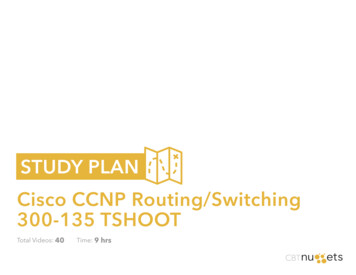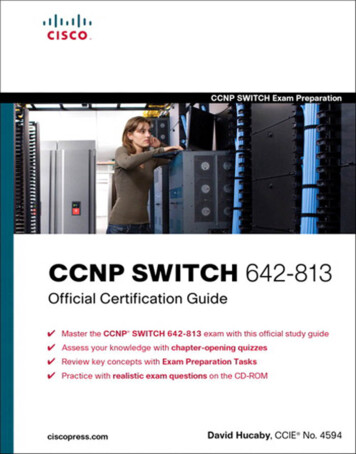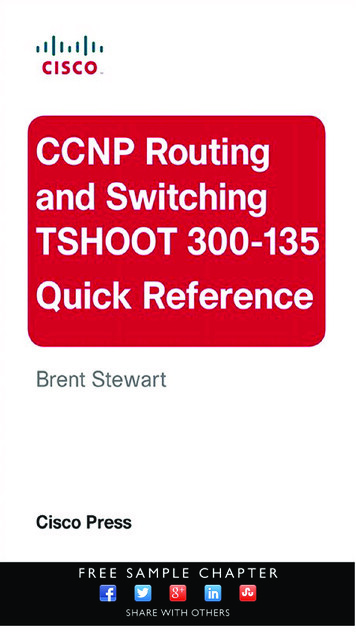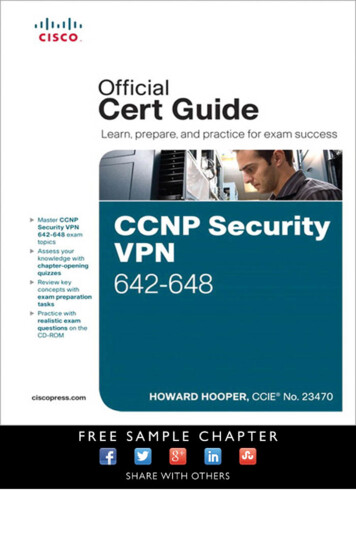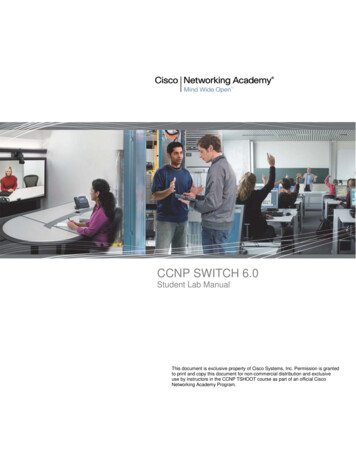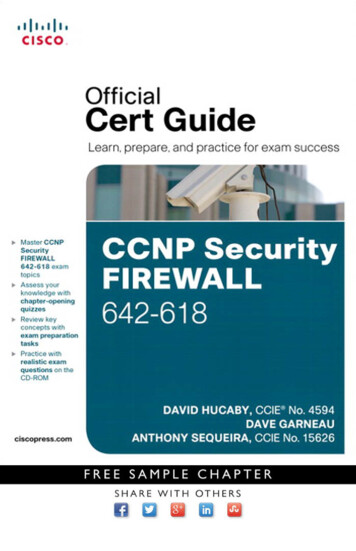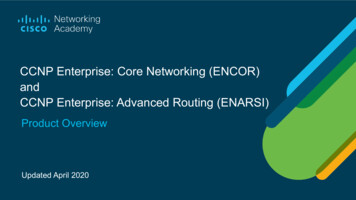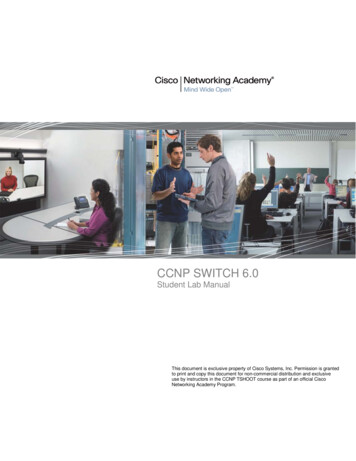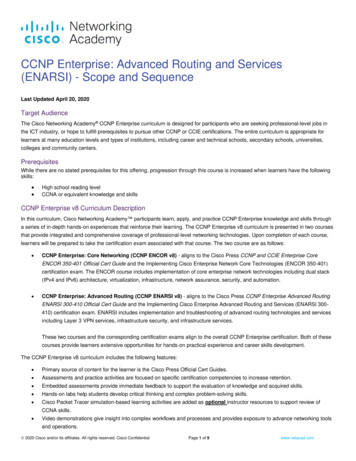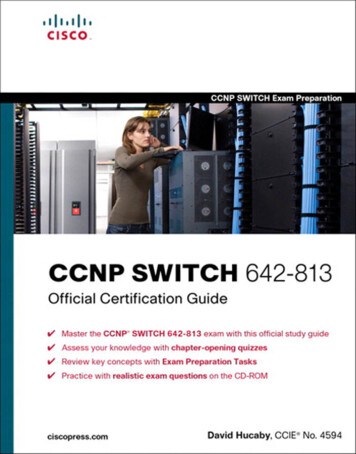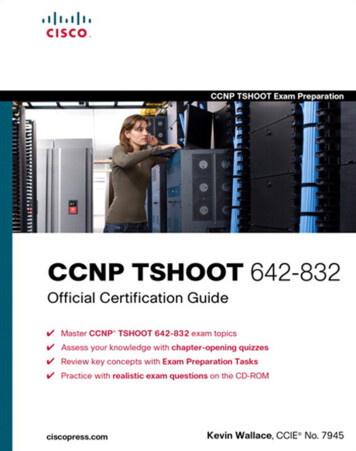
Transcription
iiCCNP TSHOOT 642-832 Official Certification GuideCCNP TSHOOT 642-832 Official Certification GuideKevin Wallace, CCIE No. 7945Copyright 2010 Pearson Education, Inc.Published by:Cisco Press800 East 96th StreetIndianapolis, IN 46240 USAAll rights reserved. No part of this book may be reproduced or transmitted in any form or by anymeans, electronic or mechanical, including photocopying, recording, or by any information storageand retrieval system, without written permission from the publisher, except for the inclusion of briefquotations in a review.Printed in the United States of AmericaFirst Printing February 2010Library of Congress Cataloging-in-Publication Data:Wallace, Kevin, CCNP.CCNP TSHOOT 642-832 official certification guide / Kevin Wallace.p. cm.Includes index.ISBN-13: 978-1-58705-844-8ISBN-10: 1-58705-844-81. Computer networks—Management—Examinations—Study guides. 2. Telecommunicationsengineers—Certification. 3. Cisco Systems, Inc.—Examinations—Study guides. I. Title.TK5105.8.C57W35 2010004.6076—dc22Warning and DisclaimerThis book is designed to provide information about the CCNP TSHOOT Exam (Exam 642-832) for theCCNP Routing and Switching certification. Every effort has been made to make this book as completeand as accurate as possible, but no warranty or fitness is implied.The information is provided on an “as is” basis. The authors, Cisco Press, and Cisco Systems, Inc. shallhave neither liability nor responsibility to any person or entity with respect to any loss or damagesarising from the information contained in this book or from the use of the discs or programs that mayaccompany it.The opinions expressed in this book belong to the author and are not necessarily those of Cisco Systems, Inc.Trademark AcknowledgmentsAll terms mentioned in this book that are known to be trademarks or service marks have been appropriately capitalized. Cisco Press or Cisco Systems, Inc., cannot attest to the accuracy of this information. Use ofa term in this book should not be regarded as affecting the validity of any trademark or service mark.Corporate and Government SalesThe publisher offers excellent discounts on this book when ordered in quantity for bulk purchases or special sales, which may include electronic versions and/or custom covers and content particular to your business, training goals, marketing focus, and branding interests. For more information, please contact: U.S.Corporate and Government Sales 1-800-382-3419 corpsales@pearsontechgroup.comFor sales outside the United States please contact: International Salesinternational@pearsoned.com
xviiForewordCCNP TSHOOT 642-832 Official Certification Guide is an excellent self-studyresource for the CCNP TSHOOT exam. Passing this exam is a crucial step to attaining thevalued CCNP Routing and Switching certification.Gaining certification in Cisco technology is key to the continuing educational development of today’s networking professional. Through certification programs, Cisco validatesthe skills and expertise required to effectively manage the modern enterprise network.Cisco Press Certification Guides and preparation materials offer exceptional—and flexible—access to the knowledge and information required to stay current in your field ofexpertise or to gain new skills. Whether used as a supplement to more traditional trainingor as a primary source of learning, these materials offer users the information and knowledge validation required to gain new understanding and proficiencies.Developed in conjunction with the Cisco certifications and training team, Cisco Pressbooks are the only self-study books authorized by Cisco and offer students a series ofexam practice tools and resource materials to help ensure that learners fully grasp theconcepts and information presented.Additional authorized Cisco instructor-led courses, e-learning, labs, and simulations areavailable exclusively from Cisco Learning Solutions Partners worldwide. To learn more,visit http://www.cisco.com/go/training.I hope that you find these materials to be an enriching and useful part of your exampreparation.Erik UllandersonManager, Global CertificationsLearning@CiscoJanuary 2010
xviiiCCNP TSHOOT 642-832 Official Certification GuideIntroduction: Overview of Certification andHow to SucceedProfessional certifications have been an important part of the computing industry formany years and will continue to become more important. Many reasons exist for thesecertifications, but the most popularly cited reason is that of credibility. All other considerations held equal, the certified employee/consultant/job candidate is considered morevaluable than one who is not.Objectives and MethodsThe most important and somewhat obvious objective of this book is to help you pass theCisco CCNP TSHOOT exam (Exam 642-832). In fact, if the primary objective of thisbook were different, the book’s title would be misleading; however, the methods used inthis book to help you pass the TSHOOT exam are designed to also make you much moreknowledgeable about how to do your job. Although this book and the accompanyingCD-ROM have many exam preparation tasks and example test questions, the method inwhich they are used is not to simply make you memorize as many questions and answersas you possibly can.The methodology of this book helps you discover the exam topics about which you needmore review, fully understand and remember exam topic details, and prove to yourselfthat you have retained your knowledge of those topics. So this book helps you pass notby memorization, but by helping you truly learn and understand the topics. TheTSHOOT exam is just one of the foundation topics in the CCNP Routing and Switchingcertification, and the knowledge contained within is vitally important to consider yourself a truly skilled routing and switching engineer or specialist. This book would do you adisservice if it did not attempt to help you learn the material. To that end, the book canhelp you pass the TSHOOT exam by using the following methods: Covering all of the exam topics and helping you discover which exam topics youhave not mastered Providing explanations and information to fill in your knowledge gaps Supplying multiple troubleshooting case studies with diagrams and diagnostic output that enhance your ability to resolve trouble tickets presented in the exam environment, in addition to real-world troubleshooting issues you might encounter Providing practice exercises on exam topics, presented in each chapter and on theenclosed CD-ROMWho Should Read This Book?This book is not designed to be a general networking topics book, although it can beused for that purpose. This book is intended to tremendously increase your chances ofpassing the Cisco TSHOOT exam. Although other objectives can be achieved from usingthis book, the book is written with one goal in mind: to help you pass the exam.
xixThe TSHOOT exam is primarily based on the content of the Cisco TSHOOT course. Youshould have either taken the course, read through the TSHOOT course material or thisbook, or have a couple of years of troubleshooting experience.Cisco Certifications and ExamsCisco offers four levels of routing and switching certification, each with an increasinglevel of proficiency: Entry, Associate, Professional, and Expert. These are commonlyknown by their acronyms CCENT (Cisco Certified Entry Networking Technician), CCNA(Cisco Certified Network Associate), CCNP (Cisco Certified Network Professional), andCCIE (Cisco Certified Internetworking Expert). There are others as well, but this bookfocuses on the certifications for enterprise networks.For the CCNP Routing and Switching certification, you must pass exams on a series ofCCNP topics, including the SWITCH, ROUTE, and TSHOOT exams. For most exams,Cisco does not publish the scores needed for passing. You need to take the exam to findthat out for yourself.To see the most current requirements for the CCNP Routing and Switching certification,go to cisco.com and click Training and Events. There you can find out other exam detailssuch as exam topics and how to register for an exam.The strategy you use to prepare for the TSHOOT exam might be slightly different thanstrategies used by other readers, mainly based on the skills, knowledge, and experienceyou have already obtained. For example, if you have attended the TSHOOT course, youmight take a different approach than someone who learned troubleshooting through onthe-job training. Regardless of the strategy you use or the background you have, thisbook is designed to help you get to the point where you can pass the exam with the leastamount of time required.How This Book Is OrganizedAlthough this book can be read cover to cover, it is designed to be flexible and enableyou to easily move between chapters to cover only the material that you need more workwith. The chapters can be covered in any order, although some chapters are related andbuild upon each other. If you do intend to read them all, the order in the book is an excellent sequence to use.Each core chapter covers a subset of the topics on the CCNP TSHOOT exam. The chapters are organized into parts, covering the following topics: Chapter 1, “Introduction to Network Maintenance”: This chapter discusses theimportance of proactive maintenance tasks, as opposed to the reactive maintenancerequired to address a problem. Also discussed in this chapter is a collection of commonly used maintenance approaches.Next, this chapter lists common maintenance tasks, emphasizes the importance ofregularly scheduled maintenance, and summarizes critical areas of network performance. Finally, this chapter identifies how to compile a set of network maintenancetools that complement your network maintenance plan.
xxCCNP TSHOOT 642-832 Official Certification Guide Chapter 2, “Introduction to Troubleshooting Processes”: This chapter addresses troubleshooting fundamentals, discusses the benefits of having a structured troubleshooting model, and discusses several popular troubleshooting models.Also discussed is each subprocess in a structured troubleshooting approach. Finally,this chapter shows how maintenance processes and troubleshooting process canwork in tandem to complement one another. Chapter 3, “The Maintenance and Troubleshooting Toolbox”: This chaptershows how a few readily accessible Cisco IOS commands can be used to quicklygather information, as part of a structured troubleshooting process.This chapter also introduces a collection of specialized features, such as SPAN,RSPAN, SMTP, NetFlow, and EEM, which can be used to collect information abouta problem. Chapter 4, “Basic Cisco Catalyst Switch Troubleshooting”: This chapterreviews the basics of Layer 2 switch operation and demonstrates a collection ofCisco Catalyst show commands that can be used to quickly gather information, aspart of a structured troubleshooting process.Also, this chapter introduces spanning tree protocol (STP), which allows a Layer 2topology to have redundant links while avoiding the side effects of a looped Layer 2topology, such as a broadcast storm. You then learn strategies for troubleshooting anSTP issue.Finally, troubleshooting an EtherChannel connection is addressed. This chapter concludes with a trouble ticket and an associated topology. You are also given showcommand output (baseline output and output collected after the reported issueoccurred). Based on the information provided, you hypothesize an underlying causefor the reported issue and develop a solution. You can then compare your solutionwith a suggested solution. Chapter 5, “Advanced Cisco Catalyst Switch Troubleshooting”: This chapterbegins by contrasting Layer 3 switches and routers. Troubleshooting procedures arealso compared for these platforms. Two approaches for routing packets using Layer 3switches are also discussed. These approaches are using routed ports and usingswitched virtual interfaces (SVIs).Next, this chapter discusses three approaches to providing first-hop router redundancy. Options include HSRP, VRRP, and GLBP. Troubleshooting strategies are discussed for HSRP with suggestions on how to modify those strategies for troubleshooting VRRP and GLBP. Examined next is the architecture of a Cisco Catalystswitch and the different architectural components that could become troubleshooting targets. You are presented with a series of show commands used to gather information about different aspects of a switch’s performance.Finally, this chapter presents you with a trouble ticket and an associated topology.You are also given show and debug command output (baseline output and outputcollected after a reported issue occurred). Based on the information provided, youhypothesize an underlying cause for the reported issue and develop a solution. Youcan then compare your solution with a suggested solution.
xxi Chapter 6, “Introduction to Troubleshooting Routing Protocols”: This chapterbegins by reviewing basic routing concepts. For example, you examine the changesto a frame’s header as that frame’s data is routed from one network to another. Yousee how Layer 2 information can be learned and stored in a router. Cisco ExpressForwarding (CEF) is also discussed. Additionally, you are presented with a collectionof show commands, useful for troubleshooting IP routing.Next, this chapter generically reviews how an IP routing protocol’s data structuresinteract with a router’s IP routing table. Then, EIGRP’s data structures are considered, followed by a review of basic EIGRP operation. Again, you are presented witha collection of show and debug commands useful for troubleshooting various EIGRPoperations.Finally, this chapter challenges you with a trouble ticket and an associated topology.You are also given show command output. Based on the information provided, youhypothesize an underlying cause for the reported issue and develop a solution. Youcan then compare your solution with a suggested solution. Chapter 7, “OSPF and Route Redistribution Troubleshooting”: This chapterbegins by introducing you to OSPF’s routing structures, followed by a review ofOSPF operation. You are then presented with a collection of show and debug commands useful for troubleshooting OSPF operations.This chapter next presents you with a trouble ticket and an associated topology. Youare also given show command output. Based on the information provided, youhypothesize an underlying cause for the reported issues and develop solutions. Youcan then compare your solutions with the suggested solutions.This chapter also introduces the concept of route redistribution and discusses how aroute from one routing process can be injected into a different routing process.Common route redistribution troubleshooting targets are identified, along withstrategies for troubleshooting route redistribution.Finally, this chapter challenges you with another trouble ticket and an associatedtopology. You are also given show command output. Based on the information provided, you hypothesize an underlying cause for the reported issue and develop asolution. You can then compare your solution with a suggested solution. Chapter 8, “Troubleshooting BGP and Router Performance Issues”: Thischapter begins by introducing you to BGP’s data structures, followed by a review ofBGP operation. You are then presented with a collection of show and debug commands useful for troubleshooting BGP operations.This chapter next presents you with a trouble ticket and an associated topology. Youare given show command output. Based on the information provided, you hypothesize an underlying cause for the reported issue and develop a solution. You can thencompare your solutions with the suggested solutions.Finally, this chapter discusses how to troubleshoot performance issues on a router,focusing on CPU utilization, packet-switching modes, and memory utilization.
xxiiCCNP TSHOOT 642-832 Official Certification Guide Chapter 9, “Security Troubleshooting”: This chapter begins by reviewing varioussecurity measures that might be put in place on Cisco routers and switches to protect three different planes of network operation. These planes are the managementplane, the control plane, and the data plane. Once you review these security measures, this chapter considers how your troubleshooting efforts might be impacted byhaving various layers of security in place.Next, this chapter describes the basic operation and troubleshooting tips for CiscoIOS firewalls and AAA services. Although complete configuration details for CiscoIOS firewalls and AAA is beyond the scope of the TSHOOT curriculum, as a reference, this chapter does provide a couple of basic configuration examples with anexplanation of the syntax used.Finally, this chapter presents you with a trouble ticket and an associated topology.You are also given show command output and a syntax reference. Based on theinformation provided, you hypothesize how to correct the reported issues. You canthen compare your solutions with the suggested solutions. Chapter 10, “IP Services Troubleshooting”: This chapter begins by reviewingthe purpose and basic operation of Network Address Translation (NAT). As a reference, sample topologies are provided, along with their configurations. Common NATtroubleshooting targets are identified, and a syntax reference is provided to aid introubleshooting NAT issues.Next, this chapter reviews Dynamic Host Configuration Protocol (DHCP) operationand various types of DHCP messages. You are given three configuration examplescorresponding to the three roles a router might play in a DHCP environment: DHCPrelay agent, DHCP client, and DHCP server. Common DHCP troubleshooting targetsare reviewed, along with recommended DHCP troubleshooting practices. This section also presents a collection of commands that could prove to be useful in troubleshooting a suspected DHCP issue.Finally, this chapter presents you with a trouble ticket and an associated topology.You are also given show and debug command output, which confirms the reportedissue. Then, you are challenged to hypothesize how to correct the reported issue.You can then compare your solution with a suggested solution. Chapter 11, “IP Communications Troubleshooting”: This chapter begins byintroducing you to design and troubleshooting considerations that arise when addingvoice traffic to a data network. Several protocols are involved when a Cisco IP Phoneregisters with its call agent in order to place and receive voice calls. You review thefunction of these protocols along with recommendations for troubleshooting voiceissues. One of the major troubleshooting targets for voice networks involves qualityof service. Therefore, this chapter provides overview of quality of service configuration, verification, and troubleshooting commands. Additionally, this chapter considers video traffic in an IP network, including video’s unique design and troubleshooting challenges.
xxiiiAlso, video-based networks often rely on an infrastructure that supports IP multicasting. Because multicasting has not been addressed in any depth thus far in this book,this chapter serves as a primer to multicast technologies. Included in this primer arecommands used to configure, monitor, and troubleshoot multicast networks. Thechapter next considers common video troubleshooting issues and recommends resolutions for those issues.Finally, this chapter presents you with two trouble tickets focused on unified communications. You are presented with a topology used by both trouble tickets, inaddition to a collection of show command output. For each trouble ticket, you arechallenged to hypothesize how to correct the reported issue. You can also compareyour solutions with suggested solutions. Chapter 12, “IPv6 Troubleshooting”: This chapter introduces the purpose andstructure of IP version 6 (IPv6) addressing. You consider the various types of IPv6addresses, routing protocols supporting IPv6, and basic syntax for enabling a routerto route IPv6 traffic. A sample configuration is provided to illustrate the configuration of a router to support IPv6. Additionally, as an organization is migrating fromIPv4 to IPv6, there might be portions of the network that are still running IPv4 withother portions of the network running IPv6. For IPv6 traffic to span an IPv4 portionof the network, one option is to create a tunnel spanning the IPv4 network. Then,IPv6 traffic can travel inside the tunnel to transit the IPv4 network. This section discusses the syntax and provides an example of tunneling IPv6 over an IPv4 tunnel.This chapter also contrasts the characteristics of two versions of OSPF, specificallyOSPFv2 and OSPFv3. OSPFv3 can support the routing of IPv6 networks, whereasOSPFv2 cannot. OSPFv3 configuration syntax is presented, along with a sample configuration. You are also provided with a collection of verification troubleshootingcommands and a listing of common OSPFv3 issues.Next, this chapter presents you with a trouble ticket addressing a network experiencing OSPF adjacency issues. You are presented with a collection of show and debugcommand output and challenged to resolve a series of misconfigurations. Suggestedsolutions are provided.Also, this chapter contrasts the characteristics of RIP next generation (RIPng) withRIPv2. You are given a set of RIPng configuration commands along with a sampleconfiguration. From a troubleshooting perspective, you compare RIPng troubleshooting commands with those commands used to troubleshoot RIPv1 andRIPv2. This chapter also discusses some of the more common RIPng troubleshooting issues you might encounter.Finally, this chapter challenges you to resolve a couple of RIPng issues beingobserved in a network. Specifically, load balancing and default route advertisementsare not behaving as expected. To assist in your troubleshooting efforts, you arearmed with a collection of show and debug command output. Your proposed solutions can then be compared with suggested solutions.
xxivCCNP TSHOOT 642-832 Official Certification Guide Chapter 13, “Advanced Services Troubleshooting”: This chapter introducesyou to Cisco’s Application Network Services (ANS) architecture. Cisco ANS includesmultiple pieces of dedicated equipment aimed at optimizing the performance of network-based applications (for example, improving the response time of a corporateweb server for users at a remote office). Although this chapter introduces a collection of Cisco ANS components, the primary focus is on Cisco IOS features that canimprove application performance. Specifically, the Cisco IOS features addressed areNetFlow, IP SLAs, NBAR, and QoS.Also, this chapter addresses the troubleshooting of wireless networks, and it beginsby contrasting autonomous and split-MAC wireless network architectures. Wirednetwork issues that could impact wireless networks are then highlighted. Theseissues include power, VLAN, security, DHCP, and QoS issues. Chapter 14, “Large Enterprise Network Troubleshooting”: This chapter beginsby identifying a collection of technologies that might become troubleshooting targets for a remote office network. The primary technologies focused on are VirtualPrivate Network (VPN) technologies. Sample syntax is provided for a VPN usingIPsec and GRE. Also, several useful show commands are provided as a troubleshooting reference.Finally, this chapter discusses the troubleshooting of complex networks, and beginsby identifying how multiple network technologies map to the seven layers of theOSI model. Also, you are given a list of resources a troubleshooter should have priorto troubleshooting a complex enterprise network. Finally, this chapter reviews keypoints from all trouble tickets previously presented. Chapter 15, “Final Preparation”: This chapter identifies tools for final exampreparation and helps you develop an effective study plan.Appendix A has the answers to the “Do I Know This Already” quizzes and an onlineappendix tells you how to find any updates should there be changes to the exam.Each chapter in the book uses several features to help you make the best use of yourtime in that chapter. The features are as follows: Assessment: Each chapter begins with a “Do I Know This Already?” quiz that helpsyou determine the amount of time you need to spend studying each topic of thechapter. If you intend to read the entire chapter, you can save the quiz for later use.Questions are all multiple-choice, to give a quick assessment of your knowledge. Foundation Topics: This is the core section of each chapter that explains the protocols, concepts, configuration, and troubleshooting strategies for the topics in thechapter. Exam Preparation Tasks: At the end of each chapter, this section collects key topics, references to memory table exercises to be completed as memorization practice,key terms to define, and a command reference that summarizes any relevant commands presented in the chapter.
xxvFinally, the companion CD-ROM contains practice CCNP TSHOOT questions to reinforce your understanding of the book’s concepts. Be aware that the TSHOOT exam willprimarily be made up of trouble tickets you need to resolve. Mastery of the topics covered by the CD-based questions, however, will help equip you with the tools needed toeffectively troubleshoot the trouble tickets presented on the exam.The CD also contains the Memory Table exercises and answer keys.How to Use This Book for StudyRetention and recall are the two features of human memory most closely related to performance on tests. This exam-preparation guide focuses on increasing both retention andrecall of the topics on the exam. The other human characteristic involved in successfullypassing the exam is intelligence; this book does not address that issue!This book is designed with features to help you increase retention and recall. It does thisin the following ways: By providing succinct and complete methods of helping you determine what yourecall easily and what you do not recall at all. By referencing the portions of the book that review those concepts you most needto recall, so you can quickly be reminded about a fact or concept. Repeating information that connects to another concept helps retention, and describing the sameconcept in several ways throughout a chapter increases the number of connectors tothe same pieces of information. Finally, accompanying this book is a CD-ROM that has questions covering troubleshooting theory, tools, and methodologies. Familiarity with these troubleshootingresources can help you be more efficient when diagnosing and resolving a reportednetwork issue.When taking the “Do I Know This Already?” assessment quizzes in each chapter, makesure that you treat yourself and your knowledge fairly. If you come across a question thatmakes you guess at an answer, mark it wrong immediately. This forces you to readthrough the part of the chapter that relates to that question and forces you to learn itmore thoroughly.If you find that you do well on the assessment quizzes, it still might be wise to quicklyskim through each chapter to find sections or topics that do not readily come to mind.Look for the Key Topics icons. Sometimes even reading through the detailed table of contents will reveal topics that are unfamiliar or unclear. If that happens to you, mark thosechapters or topics, and spend time working through those parts of the book.CCNP TSHOOT Exam TopicsCarefully consider the exam topics Cisco has posted on its website as you study, particularly for clues to how deeply you should know each topic. Also, you can develop a broader knowledge of the subject matter by reading and studying the topics presented in this
xxviCCNP TSHOOT 642-832 Official Certification Guidebook. Remember that it is in your best interest to become proficient in each of the CCNPsubjects. When it is time to use what you have learned, being well rounded counts morethan being well tested.Table I-1 shows the official exam topics for the TSHOOT exam, as posted on cisco.com.Note that Cisco has occasionally changed exam topics without changing the exam number, so do not be alarmed if small changes in the exam topics occur over time. When indoubt, go to cisco.com and click Training and Events.Table I-1CCNP TSHOOT Exam TopicsExam TopicsChapters WhereExam TopicsAre CoveredMaintain and monitor network performanceDevelop a plan to monitor and manage a networkPerform network monitoring using IOS toolsPerform routine IOS device maintenanceIsolate sub-optimal internetwork operation at thecorrectly defined OSI Model layerChapters 1–3 and 14Troubleshooting IPv4 and IPv6 routing protocols and IP services in amultiprotocol system networkTroubleshoot EIGRPTroubleshoot OSPFTroubleshoot eBGPTroubleshoot routing redistribution solutionTroubleshoot a DHCP client and server solutionTroubleshoot NATTroubleshoot first-hop redundancy protocolsTroubleshoot IPv6 routingTroubleshoot IPv6 and IPv4 interoperabilityChapters 5–8, 10,and 12Troubleshoot switch-based featuresTroubleshoot switch-to-switch connectivity for aVLAN-based solutionTroubleshoot loop prevention for a VLAN-based solutionTroubleshoot access ports for a VLAN-based solutionTroubleshoot private VLANSTroubleshoot port securityTroubleshoot general switch securityTroubleshoot VACL and PACLTroubleshoot switch virtual interfaces (SVIs)Troubleshoot switch supervisor redundancyTroubleshoot switch support of advanced servicesTroubleshoot a VoIP support solutionTroubleshoot a video support solutionChapters 4–5, 11,and 13
xxviiTable I-1CCNP TSHOOT Exam Topics(Continued)Exam TopicsChapters WhereExam TopicsAre CoveredTroubleshoot Cisco router and switch device hardeningTroubleshoot Layer 3 securityTroubleshoot issues related to ACLs used to secure accessto Cisco routersTroubleshoot configuration issues related to accessing anAAA server for authentication purposesTroubleshoot security issues related to IOS servicesChapters 9 and
CCNP TSHOOT 642-832 Official Certification Guideis an excellent self-study resource for the CCNP TSHOOT exam. Passing this exam is a crucial step to attaining the valued CCNP Routing and Switching certification. Gaining certification in Cisco technology is key to the continuing educational develop-ment of today's networking professional.

